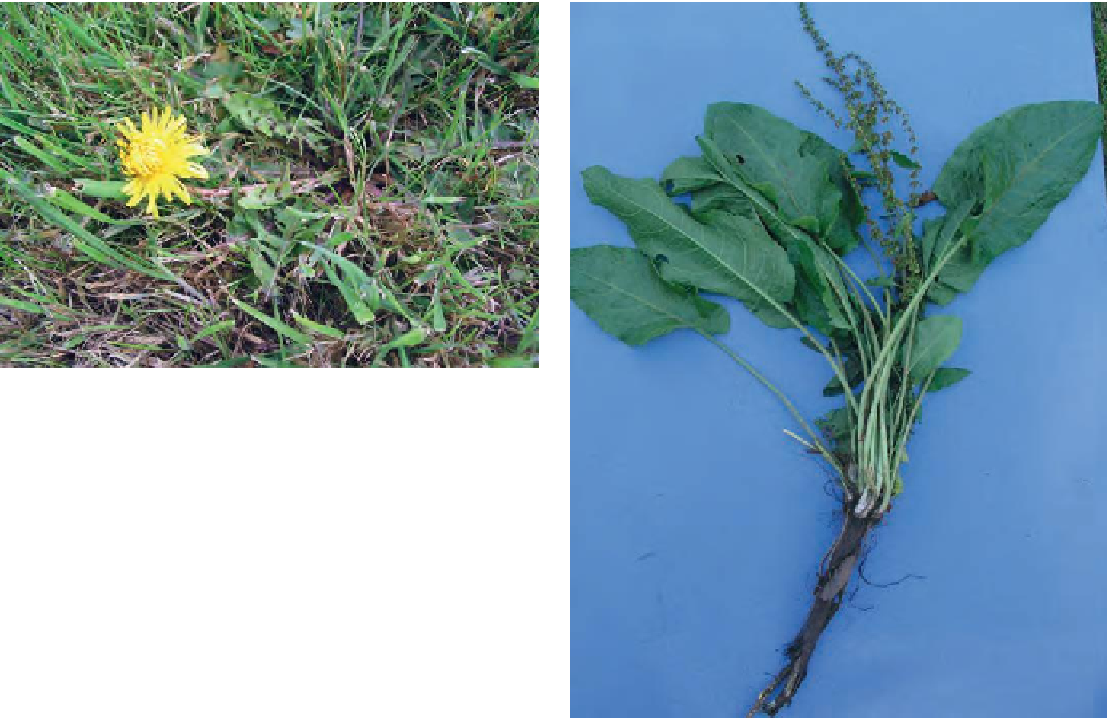Agriculture Reference
In-Depth Information
Figure 17.20
Dandelion plant growing in turf
Dandelion (
Taraxacum officinale
)
This belongs to the plant family Asteraceae
(Compositae).
Damage and location
. This species is a perennial
with a stout
taproot
. It is a weed in lawns (Figure
17.20), orchards, and on paths. Several similar species
such as mouse-ear hawkweed (
Hieracium pilosella
)
and smooth hawk's beard (
Crepis capillaris
) present
problems similar to dandelion in turf.
Life cycle
. Seedlings emerge mainly in March and
April. Flowers are produced from May to October. An
average of 6,000 seeds is produced by each plant.
Most seeds survive only one year in the soil, but a
few may survive up to five years. Mature plants can
survive for 10 years.
Spread
. Seeds are wind dispersed by means of tiny
'parachutes' and may travel several hundred metres.
They are also able to spread in the moving water found in
ditches and by animals through their digestive systems.
The plant may survive and regenerate from roots, after
they have been chopped up by spades or rotavators.
Control
. Physical removal of the deep root by a sharp
trowel is recommended, but this leaves bare gaps
in turf for invasion by other weeds. Gardeners use
products containing the two translocated ingredients
2,4-D
and
dicamba
that can reach and kill the stout
root of the dandelion.
Glyphosate
can be used for
control in such situations as bare soil and ornamental
beds containing woody perennials, and in cane fruit,
but
not
in growing crops. Great care is needed to
avoid spraying foliage of garden plants.
Figure 17.21
Broad-leaved dock showing a swollen
taproot
Life cycle
. The seedling cotyledons are narrow (Figure
17.5). The seedling's first true leaves are broad and
often crimson-coloured. The mature plant is readily
identified by its long (up to 25 cm) shiny green leaves
(Figure 17.21), known to many as a cure for 'nettle
rash'. The plant may grow 1 m tall, producing a
conspicuous branched inflorescence of small green
flowers from June to October. The seed represents
an important stage in this perennial weed's life cycle,
surviving many years in the soil and most commonly
germinating in spring. Like most
Rumex
spp., the
seedling develops a stout, branched taproot, which
may penetrate the soil down to 1 m in the mature
plant, but most commonly reaches 25 cm. Segments
of the taproot, chopped by digging and rotavating, are
capable of producing new plants.
Spread
. The numerous plate-like fruits (3 mm long)
may fall to the ground or be dispersed by seed-eating
birds such as finches. They are sometimes found in
commercial batches of seed.
Control
. High levels of seed production, a tough
taproot and a resistance to most herbicides present a
problem in the control of this weed.
Broadleaved dock (
Rumex obtusifolius
)
This belongs to the plant family Polygonaceae.
Damage and location
. This is a common perennial
weed in vegetable plots, turf and bare soil.

